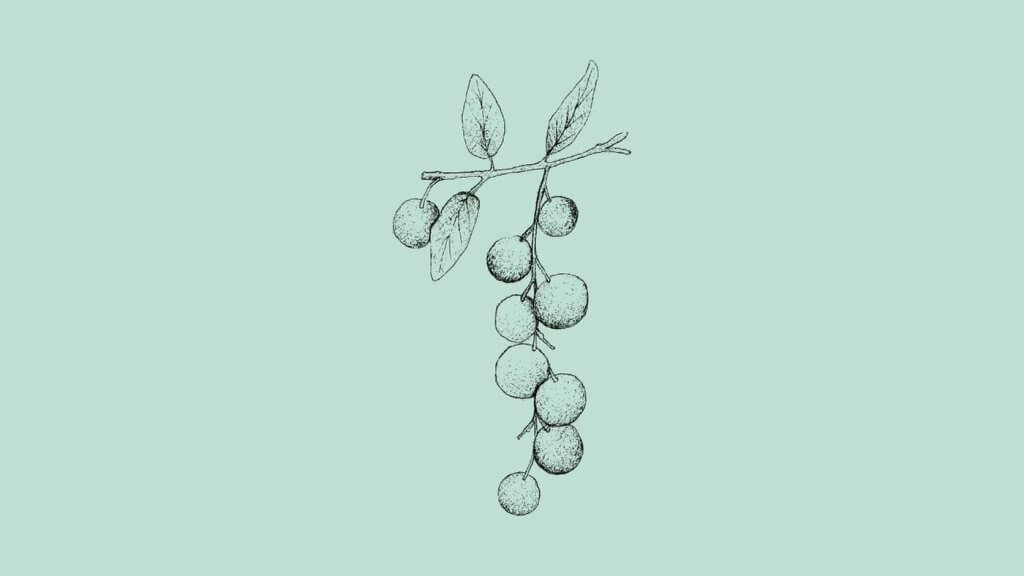Prunus virginiana, common name chokecherry, is a species of flowering shrub or small tree native to North America. It belongs to the Rosaceae family and is known for its small, dark berries that are typically astringent and sour when eaten fresh but can be used in various culinary and medicinal preparations when properly processed.
Chokecherry is an interesting tree for all foragers. If you want to know how to use chokecherries in recipes, keep reading!
Do Chokecherry Trees grow in the Wild?
Yes, chokecherries are commonly found growing in the wild in various regions of North America.
They can be found in forests, woodlands, meadows, stream banks, and along roadsides.
What Are You Foraging For Right Now?
We're thrilled to hear your ideas. What would you like to submit today? Feel free to share your thoughts and experiences with us.
How to Identify a Chokecherry tree?
Here’s how to identify a chokecherry tree:
Leaves:
- Chokecherry leaves are alternate, meaning they are arranged singly along the stem rather than in pairs.
- They have serrated (toothed) edges, and the veins are prominently visible on both sides of the leaf.
- The upper surface of the leaves is dark green, while the underside is paler.
Flowers:
- Chokecherry trees produce clusters of white, showy flowers in spring. Chokecherry trees’ bloom time is late spring to early summer, typically from late May to early June.
- The flowers are small and have five petals each. They are arranged in elongated clusters called racemes.
Fruits:
- The most distinctive feature of chokecherry trees is their dark purplish-black berries.
- The berries grow in clusters and are about the size of small cherries. They are typically one-quarter to half an inch in diameter.
- The berries are edible when properly processed, such as cooking and sweetening, to reduce their natural astringency.
Height:
- Chokecherry trees can vary in size from shrubs to small trees, typically reaching heights of 15 to 25 feet (4.5 to 7.5 meters).
Cultivars:
- Schubert
- Canada red
- Garrington
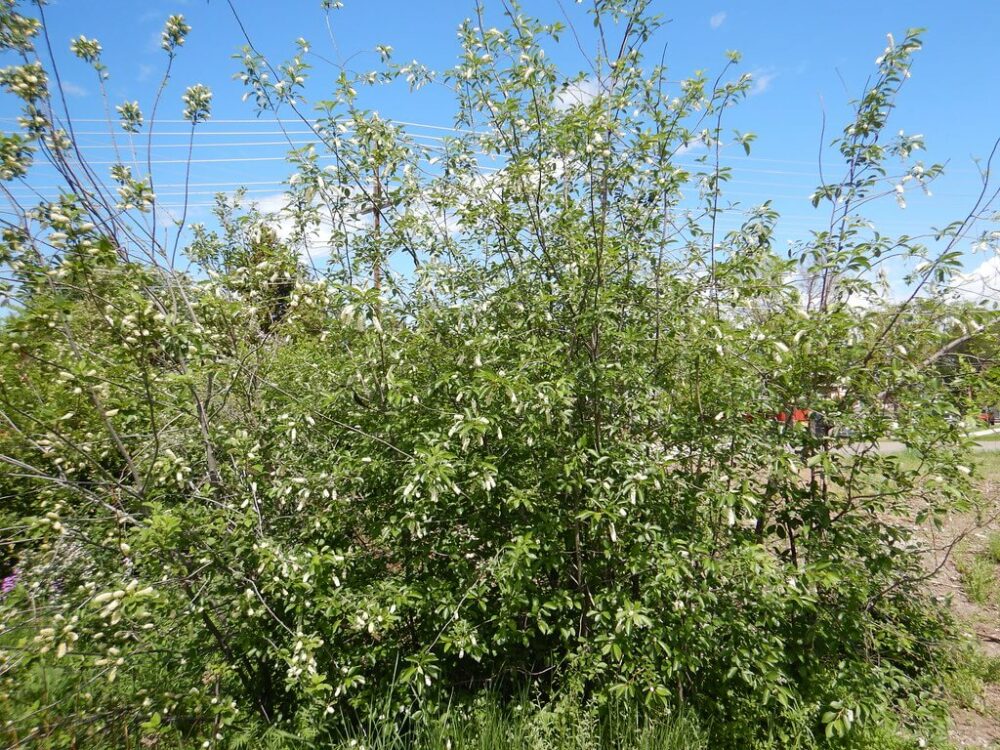
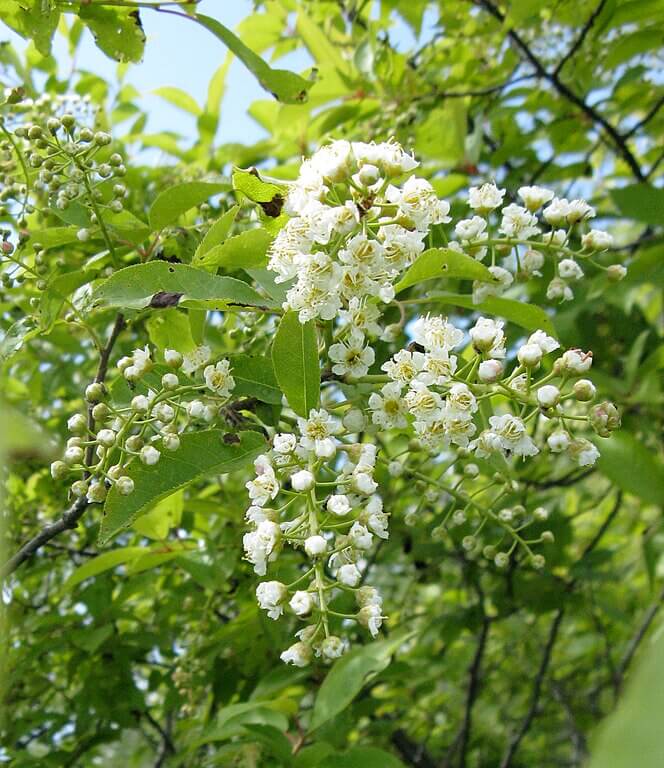
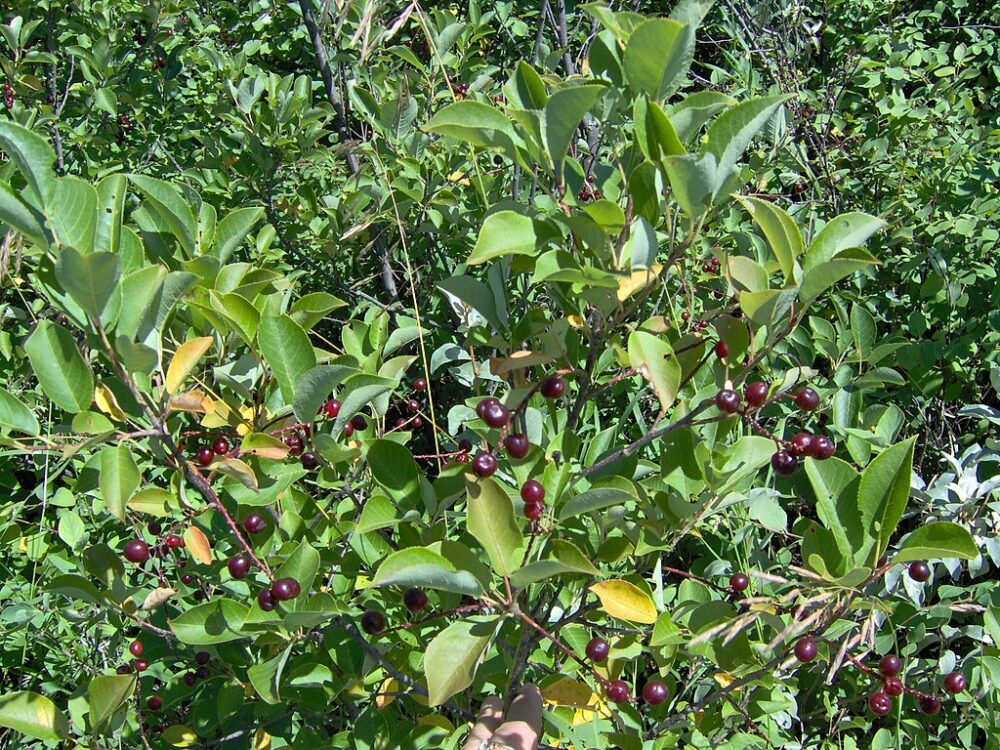
Why is it called a chokecherry?
The name reflects the sensation that the fruit can cause in the mouth as if it were causing a choking or constricting feeling due to its astringency.
When consumed in its natural state, chokecherry fruit can be quite tart and astringent, causing a puckering sensation similar to what happens when consuming unripe persimmons.
Similar fruits with a sweeter taste I recommend trying out include:
Can you eat chokecherries?
Yes, chokecherries are edible, but they are typically not eaten raw due to their astringent and tart taste.
The leaves, stems, bark, and other parts of the chokecherry tree are not typically consumed by humans. In fact, these parts contain compounds that are not suitable for consumption.
Check out our video on how to use chokecherries in recipes and for medicinal purposes.
Do chokecherries taste like cherries?
Chokecherries do have a resemblance to sweet cherries in terms of their appearance, as they are small, dark-purple to black berries that grow in clusters. However, their taste is very different from the sweet cherries.
Chokecherries are tart, while cherries are a lot sweeter.
What is the difference between chokecherry and chokeberry (Aronia)?
While both chokecherry and chokeberry produce berries that are edible, they are 2 different trees.
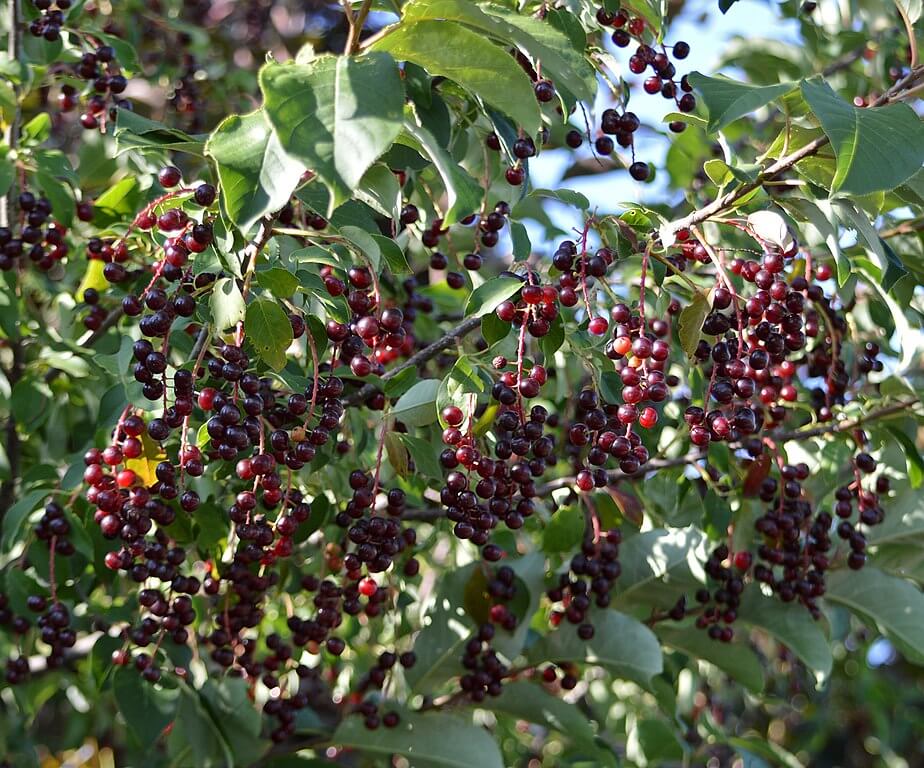
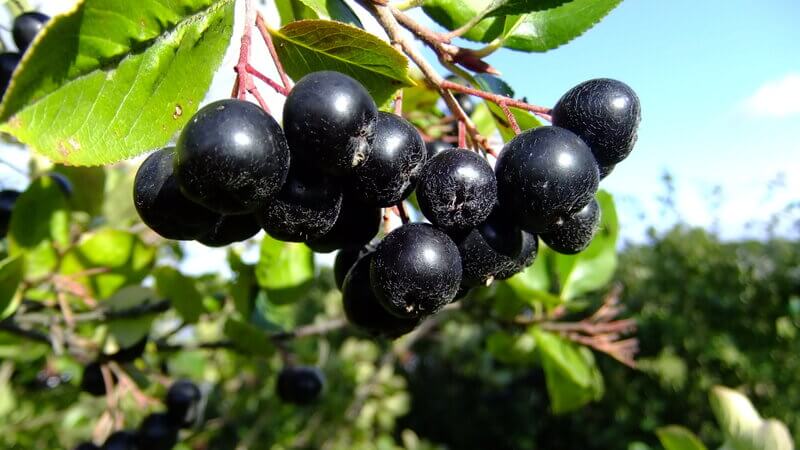
How to Prepare chokecherries & Our Favorite Recipe
- Remember that the seeds inside chokecherries contain compounds that can release cyanide when crushed, so it’s best to remove the seeds before consuming the berries.
- Cooking chokecherries is one of the most common ways to prepare them. Cooking helps soften the berries and reduce their astringency.
- You can cook chokecherries on the stovetop with water, then strain them to remove the skins and seeds. You can sweeten the resulting pulp to make jams, jellies, or syrups.
- You can juice chokecherries by blending the berries and then straining the mixture to remove solids. The resulting juice can be sweetened and used as a beverage or a base for various recipes.
- Chokecherries can also be dried to preserve them for later use. After removing the pits and stems, spread the berries on a tray and dry them in a food dehydrator or an oven set to a low temperature.
Chokecherry Jelly Recipe
Ingredients:
- 4 cups chokecherries (stemmed and washed)
- 4 cups water
- 1 package (1.75 oz) fruit pectin (such as Sure-Jell)
- 5 cups granulated sugar
Instructions:
Extract Juice:
- Place the chokecherries in a large pot and add the water. Bring the mixture to a boil and then reduce the heat to a simmer.
- Simmer the chokecherries for about 15 to 20 minutes, mashing them occasionally with a potato masher to release the juice.
- Remove the pot from the heat and let the mixture cool slightly.
Strain Juice:
- Set up a fine-mesh strainer or a jelly bag over a large bowl. Strain the cooked chokecherries to separate the juice from the solids. You can gently press the solids to extract more juice, but avoid forcing too much pulp through the strainer.
Cook the Jelly:
- In a large pot, combine the chokecherry juice and the package of fruit pectin. Stir to mix well.
- Bring the mixture to a rolling boil over high heat. Once boiling, add the granulated sugar all at once and stir to dissolve.
- Return the mixture to a boil and cook for 1 to 2 minutes, stirring constantly. The mixture should thicken and reach the jelly stage.
Fill Jars:
- Remove the pot from the heat and carefully skim off any foam from the surface of the jelly.
- Ladle the hot chokecherry jelly into the sterilized canning jars, leaving about 1/4-inch headspace at the top.
Once cooled, store the chokecherry jelly in a cool, dark place.
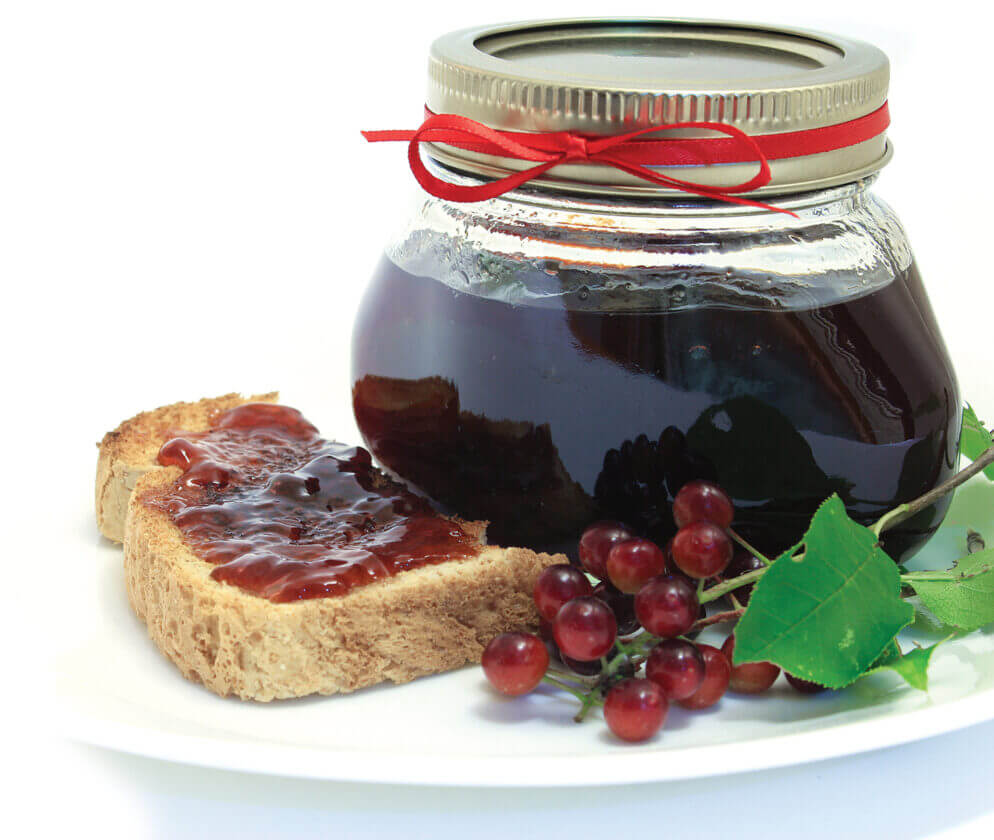
Other plants you can forage to use for delicious jellies include:
Where does Chokecherry grow?
Chokecherry is a native plant in North America. Its range extends from Canada down to Mexico (USDA hardiness zones 2 to 7).
Chokecherry can thrive in a variety of habitats, including:
- Woodlands: It can be found in open woodlands, deciduous forests, and mixed forests.
- Meadows and Clearings: Chokecherry often grows in open areas, meadows, and clearings.
- Water Areas: It is commonly found along the edges of streams, rivers, and other water bodies.
- Wetlands: Chokecherry can tolerate wet and marshy conditions, making it a common sight in wetlands and swampy areas.
- Upland Areas: It can also grow in upland areas, particularly in regions with a temperate climate.
From an environmental standpoint, chokecherries are often deliberately used to prevent soil erosion or to create a food source and habitat for local wildlife. Its prolific white flowers are a powerful draw for pollinators of all kinds including the silk moth.
It is particularly well known as a favorite home for:
- Tent caterpillars
- Aphids
- Coral and striped hairstreak
These are not positives as these are known pests and are often a threat to other fruit trees and nearby plants.
Are chokecherry trees invasive?
Chokecherry trees are not considered invasive. In North America, chokecherries are a natural part of the ecosystem.
What are the major enemies of chokecherry trees?
1. Insects and Pests:
- Chokecherry Borer
- Chokecherry Leafhopper
- Aphids
2. Diseases:
- Black Knot
- Leaf Spot Diseases
- Fire Blight
Is chokecherry poisonous to dogs?
Yes, chokecherry can be toxic to dogs. Ingesting even small amounts of chokecherries, particularly the leaves, stems, or seeds, can lead to cyanide poisoning in dogs.
It’s important to prevent dogs from accessing chokecherries or areas where chokecherry plants grow.
What to read next: Foraging And Cooking Cocoplums
Lorin is a writer, photographer and nature enthusiast in Sacramento, CA. In addition to gardening, she makes a regular practice of forging for edible plants and flowers. Nature nourishes if you know where to look.

